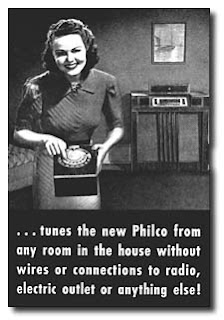Recently I was afforded the opportunity to visit the Pavek Museum of Broadcasting in St. Louis Park, Minnesota. The museum began life as the private collection of Joseph R. Pavek. A traveling salesman that made it a regular habit to stop into every small town barber shop for a quick trim and to ask the same question, "Do you know anyone with an old radio they don’t want?"In Mr. Pavek’s day the barber knew everyone in towns business.


There were a plethora of interesting exhibits. The first that springs to mind was a musical performance that was recorded simultaneously for acoustic 78RPM record (A horn captured the sound which was then cut directly into the master. No electricity was necessary) and electrical 78RPM record (Microphones and something approaching modern recording technics.) flipping between them was a snap. Of course the electrically recorded version had much better bass response, a more transparent midrange, and more a more accurate presentation of brass instruments. The gentleman guiding the tour briefly mentioned that when electrical recordings made their debut felt that they were markedly inferior to the old acoustical recordings. Thus was born Audio Luddism.
The next exhibit that inspired my imagination was when our tour guide was nice enough to play a Bing Crosby recording on an early Ampex ¼” reel to reel tape deck using a Marantz 5B tube amp and a huge pair of Western Electric horn speakers that were originally designed for movie theater use (I would estimate that the mouth of these horns was roughly 5’ by 7’, yes I meant feet!) The sound was stunning and immediate! Apparently, Mr. Crosby was an early investor in Ampex, supporting an American GI that had brought back some German machines after World War II. He used the Ampex machines to record his radio show so that he could complete it on his schedule, not allowing himself to be a slave to the time slot.


Perhaps the most amazing item on display was a Philco radio from 1939 It featured six AM presets and a wireless RF remote, that used a rotary dial similar to what was used on telephones. The range, an astonishing 200 feet! Something that would have been amazing had it been working was a 78RPM record changer that would play one side of the disc, then flip it to play the other side automatically. Unfortunately it had malfunctioned the previous day snapping a shellac in two, just my luck.


Perhaps the most amazing item on display was a Philco radio from 1939 It featured six AM presets and a wireless RF remote, that used a rotary dial similar to what was used on telephones. The range, an astonishing 200 feet! Something that would have been amazing had it been working was a 78RPM record changer that would play one side of the disc, then flip it to play the other side automatically. Unfortunately it had malfunctioned the previous day snapping a shellac in two, just my luck.
In one of the earliest examples of decorators trying to hide audio systems as to not ruin the décor of a room was a 78RPM turntable disguised as a lamp. The shade hid the turntable, and the body of the lamp was a brass horn that emitted the music. It was also a working lamp. The sound, well let’s just say that it was the Bose of it’s time. Feel free to draw your own conclusions.
Also on display was an original Theremin utilizing all tube electronics. I was even granted permission to "play" it. That was a very cool experience. I’m no Jimmy Page, let me tell you. Another interesting tidbit was a Mechanical Television with a resolution of 48 lines (If I remember correctly.) It consisted of a spinning disc drilled with holes and an eye piece that the view looked through. Broadcasts were over AM radio frequencies and most viewers built their own "televisions."
If anyone is in the St. Louis Park, Minnesota area a visit is mandatory. My tour was courtesy of Tom Mittelstaedt who was obviously equal parts passionate and knowledgeable. The Pavek is located at 3515 Raleigh Avenue in Saint Louis Park, just east of Highway 100, off the West 36th Street exit. They are open to the public five days a week and are also available for special tours and evening meetings. Call the Museum at (952) 926-8198 to make reservations for group tours or just stop in for a visit. Their website is www.pavekmuseum.org It’s not to be missed.


Also on display was an original Theremin utilizing all tube electronics. I was even granted permission to "play" it. That was a very cool experience. I’m no Jimmy Page, let me tell you. Another interesting tidbit was a Mechanical Television with a resolution of 48 lines (If I remember correctly.) It consisted of a spinning disc drilled with holes and an eye piece that the view looked through. Broadcasts were over AM radio frequencies and most viewers built their own "televisions."
If anyone is in the St. Louis Park, Minnesota area a visit is mandatory. My tour was courtesy of Tom Mittelstaedt who was obviously equal parts passionate and knowledgeable. The Pavek is located at 3515 Raleigh Avenue in Saint Louis Park, just east of Highway 100, off the West 36th Street exit. They are open to the public five days a week and are also available for special tours and evening meetings. Call the Museum at (952) 926-8198 to make reservations for group tours or just stop in for a visit. Their website is www.pavekmuseum.org It’s not to be missed.







No comments:
Post a Comment